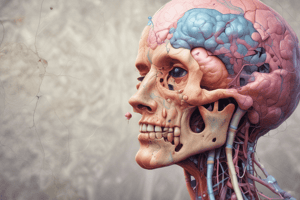Podcast
Questions and Answers
What are the two main sources of genetic changes that can lead to cancer?
What are the two main sources of genetic changes that can lead to cancer?
Genetic changes can be inherited or arise from environmental exposures.
How do tumor suppressor genes function in normal cells?
How do tumor suppressor genes function in normal cells?
Tumor suppressor genes prevent cancer by slowing or stopping cell growth.
What role do immune system cells play in combating cancer?
What role do immune system cells play in combating cancer?
Immune system cells can detect and attack cancer cells.
What is the tumor microenvironment and how can cancer cells affect it?
What is the tumor microenvironment and how can cancer cells affect it?
What happens to the body's ability to eliminate cells with damaged DNA as we age?
What happens to the body's ability to eliminate cells with damaged DNA as we age?
What distinguishes benign tumors from malignant tumors?
What distinguishes benign tumors from malignant tumors?
How do cancer cells typically spread throughout the body?
How do cancer cells typically spread throughout the body?
What role do genetic changes play in cancer development?
What role do genetic changes play in cancer development?
What are some therapeutic strategies used to combat cancer?
What are some therapeutic strategies used to combat cancer?
Why can benign tumors sometimes be considered life-threatening?
Why can benign tumors sometimes be considered life-threatening?
Flashcards are hidden until you start studying
Study Notes
Benign vs. Cancerous Tumors
- Benign tumors do not invade or spread to surrounding tissues; when removed, they typically do not recur.
- Benign tumors can grow large and may cause serious symptoms, especially if located in sensitive areas, such as the brain.
- Cancerous (malignant) tumors invade nearby tissues and can spread to distant sites in the body, forming new tumors through a process called metastasis.
- Solid tumors are common in many cancers; however, blood cancers like leukemia generally do not form solid tumors.
The Nature of Cancer
- Cancer originates from the uncontrolled growth of the body's cells and can develop in nearly any tissue due to genetic changes.
- Cell division is a natural process where new cells are created as older cells die; cancer disrupts this cycle.
- Some cancer cells exhibit abnormal behaviors essential for their survival, which can be targeted by specific therapies.
Metastasis and Genetic Factors
- Cancer cells can detach from primary tumors and travel via blood or lymphatic systems to establish secondary tumors, known as metastasis.
- As individuals age, the accumulation of genetic changes increases the risk of developing cancer.
- Genetic alterations can be inherited, stem from environmental exposure, or occur from errors during cell division.
Immune Response to Cancer
- The immune system can recognize and attack cancer cells, but some cancer cells develop mechanisms to evade this detection.
- Certain cancer treatments aim to enhance the immune system's ability to identify and eliminate cancer cells.
Tumor Microenvironment
- Within tumors, cancer cells interact with immune cells, fibroblasts, and blood vessels, collectively referred to as the tumor microenvironment.
- The microenvironment can influence cancer behavior and progression, creating a feedback loop that affects growth.
Genetic Changes and Cancer Development
- Tumor suppressor genes normally control cell growth; mutations that inactivate these genes can lead to unchecked cell proliferation.
- DNA mutations can transform regular genes into oncogenes, which promote continuous cell division without regulatory control.
- Each cancer case has a distinct set of genetic changes, and even within a tumor, there can be variation among cell genetic profiles.
Aging and Cancer Risk
- The body's efficiency in eliminating cells with damaged DNA declines with age, contributing to the increased risk of cancer later in life.
- Cancer is fundamentally a genetic disease initiated by alterations in genes that regulate cellular functions, particularly growth and division.
Studying That Suits You
Use AI to generate personalized quizzes and flashcards to suit your learning preferences.




